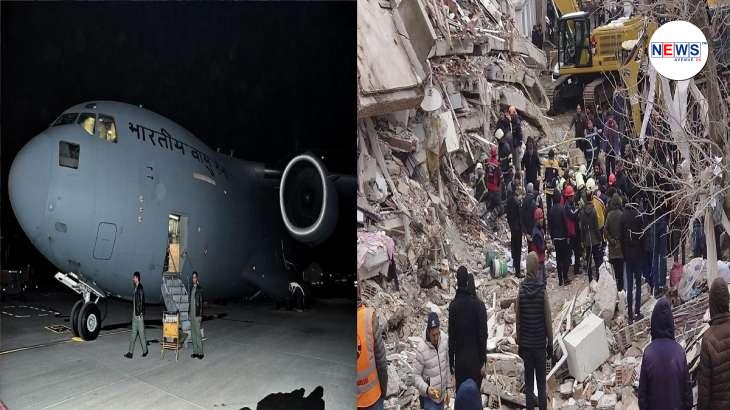
Turkey earthquake LIVE UPDATE: India dispatches first consignment of relief material; death toll 4,000
Turkey earthquake LIVE UPDATE: Several countries, including India, came forward to provide humanitarian relief to the earthquake-hit nations.
Turkey earthquake LIVE UPDATE: India dispatched the first batch of earthquake relief material to Turkey aboard an Indian Air Force aircraft, said MEA on Tuesday. The move came hours after the announcement made by the Prime Minister’s Office to provide relief assistance to the earthquake-hit nation.
India’s Humanitarian Assistance and Disaster Relief (HADR) capabilites in action.
The 1st batch of earthquake relief material leaves for Türkiye, along with NDRF Search & Rescue Teams, specially trained dog squads, medical supplies, drilling machines & other necessary equipment. pic.twitter.com/pB3ewcH1Gr
— Arindam Bagchi (@MEAIndia) February 6, 2023
The shipment consisted of an expert National Disaster Response Force search and rescue team, including both male and female personnel, highly-skilled dog squads, an array of medical supplies, advanced drilling equipment, and other crucial tools required for the aid efforts.
Deeply pained to learn that the devastating earthquake has also affected Syria. My sincere condolences to the families of the victims. We share the grief of Syrian people and remain committed to provide assistance and support in this difficult time.
— Narendra Modi (@narendramodi) February 6, 2023
India’s Humanitarian Assistance and Disaster Relief (HADR) capabilities in action. The 1st batch of earthquake relief material leaves for Turkiye, along with NDRF Search and Rescue Teams, specially trained dog squads, medical supplies, drilling machines and other necessary equipment,” Arindam Bagchi, spokesperson of the Ministry of External Affairs tweeted.
PM Modi’s message
Earlier, Prime Minister Narendra Modi expressed his heartfelt condolences to the bereaved families and wished for a speedy recovery of the injured.
He also instructed officials to offer all possible assistance in coping with the aftermath of the earthquake, killing at least 4,000 people. “Anguished by the loss of lives and damage of property due to the earthquake in Turkey. Condolences to the bereaved families. May the injured recover soon,” PM Modi said in a tweet.
Turkey’s response to India
Turkish Ambassador to India Firat Sunel expressed his gratitude towards the Indian government’s offer of assistance and said that “a friend in need is indeed a friend”. He also mentioned a Turkish proverb, “Dost kara gunde belli olur”, which means “a friend in need is a friend indeed”.
Deadliest Turkey-Syria earthquake
Earlier, a powerful earthquake of 7.8 magnitudes hit southern Turkey and northern Syria early Monday, resulting in the killing of more than 3,700 people. The death toll stood at 2,316 in Turkey, and 1,444 in Syria.
According to the Turkish government, the death toll was likely to increase as rescuers continue to look for survivors amid the rubble of collapsed buildings. Subsequently, the country declared seven days of national mourning.
The citizens witnessed three other powerful tremors on Monday, with authorities warning people to be cautious for more aftershocks. The rescue workers are currently sawing away slabs and pulling out bodies as desperate families waited for news on trapped loved ones.
Victims’ reactions
“My grandson is 1 1/2 years old. Please help them, please. We can’t hear them or gotten any news from them since morning. Please, they were on the 12th floor,” Imran Bahur wept at her destroyed apartment building in the Turkish city of Adana. Her daughter and family were still not found.
The quake, which was centred on Turkey’s southeastern province of Kahramanmaras, sent residents of Damascus and Beirut rushing into the street and was felt as far away as Cairo.
Meanwhile, in a video address, Turkish Vice President Fuat Oktay claimed such a disaster could hit “once in a hundred years.” While Turkish President Recep Tayyip Erdogan ascertained the death toll could reach more than 3,000 as rescuers fished out the bodies of the victims.
What happened?
The quake hit at depth of 18 kilometers and was centered in southern Turkey, near the northern border of Syria, according to the US Geological Survey. Many aftershocks have rocked the area since the initial quake. In the first 11 hours, the region had felt 13 significant aftershocks with a magnitude of at least 5, said Alex Hatem, a USGS research geologist. Scientists are studying whether a magnitude 7.5 quake that hit nine hours after the main shock is an aftershock. Hatem said it appears to be the case.
“More aftershocks are certainly expected, given the size of the main shock,” Hatem said. “We expect aftershocks to continue in the coming days, weeks and months.”
What type of earthquake was this?
Researchers said the earthquake was a strike-slip quake, where two tectonic plates slide past each other horizontally, instead of moving up and down. In this case, one block moved west while the other moved east — grinding past each other to create the quake, Hatem said. The quake occurred in a seismically active area known as the East Anatolian fault zone, which has produced damaging earthquakes in the past. Turkey had another major earthquake in January 2020 — a magnitude 6.7 that caused significant damage.
Why was this so devastating?
The earthquake was powerful — one of the biggest strike-slip earthquakes that has hit on land, Hatem said. “On top of that, it’s located near populated areas,” she said. Building collapses were reported in cities including Diyarbakir, Turkey, and Aleppo, Syria. Rescue efforts were also hampered by freezing temperatures and traffic jams from residents trying to leave quake-stricken areas.
Why Turkey is prone to earthquakes?
An earthquake usually depends on geographical settings and the movement of tectonic plates. In case of Turkey, it is located mainly on the Anatolian Peninsula in Western Asia.
The region sits on top of major fault lines and is considered the most earthquake-prone country in the world. The region is located on the Anatolian tectonic plate which comprises three major tectonic plates– African, Arabian and Eurasian.
aerial images from #Turkey post the massive #Earthquake today
Just heartbreaking pic.twitter.com/WQBbwnLBF8
— Abier (@abierkhatib) February 6, 2023
According to Seismicity of Turkey and Real-Time Seismology Applications in Determining Earthquake Hazard, the Turkish/Anatolian plate is surrounded by African and Arabian plates in the south, the Eurasian plate in the north, and the Aegean plate in the west. Relative motions between the African, Arabian and Eurasian plates account for most of the tectonic activity in the region. As a result, the Anatolian plate has a high danger of seismicity.
News Sources – India Tv News





